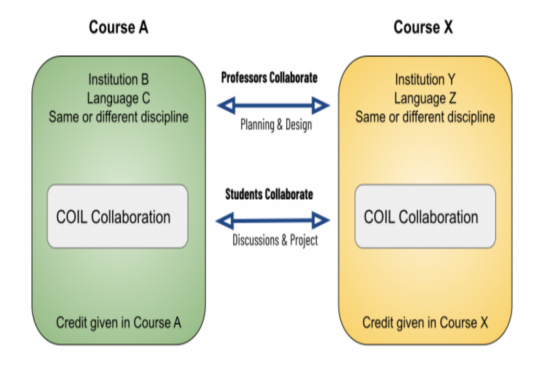WATCH
VIDEO
Building upon existing relationships, or after identifying an
international partner with the help of the COIL Coordinator and
COIL networks, faculty at separate institutions (in other
countries, or even other parts of the United States) create
collaborative course projects that support mutual student
learning outcomes and foster active learning, as issues are
explored through diverse cultural perspectives/contexts. Courses
may be taught in a common language, or if a common language is
not possible translation tools can be utilized to allow students
to participate using the language of course instruction.

As the SUNY COIL Model indicates, projects:
- Can be created in any discipline; interdisciplinary
collaborations work really well
- Encourage active student learning and teamwork
- Include an emphasis on cross-cultural interactions and
understanding
- Can be 5-15 weeks long
- Are a graded activity in each participating class
- Can use any technology tools that serve the learning goals
- Conclude with a post-project critical reflection that
typically incorporates consideration of the global/cultural
aspects of the activities
Progression of a COIL Module
- Icebreakers; teambuilding; developing trust
- Comparative discussion; organizing teams
- Collaborative project work; problem-solving
- Presentation; reflection; conclusion
The COIL model provides infrastructure, resources, and faculty
development opportunities to support the development, design,
facilitation, and assessment of curricular experiences, and
supports related research, publications, presentations, and
grant-writing. Our participation in COIL networks can streamline
access to partner institutions throughout the world, and provide
support to the development of new curricular collaborations.
Central to this work is an emphasis on culturally engaged
pedagogies, the implementation of teaching and learning practices
that foster intercultural awareness and skills as students engage
in content-related activities. Faculty remain in control over
partnerships and course activities, but with support and
resources to streamline the development of relationships,
communication tools, responsibilities, etc.
Want to see some examples?
Since COIL is new to Stan State, we don’t yet have projects to
share from our campus, but the following links offer examples of
COIL collaborations that may inform and inspire you: